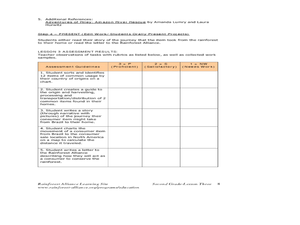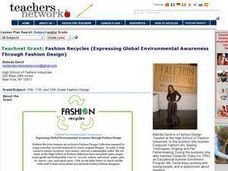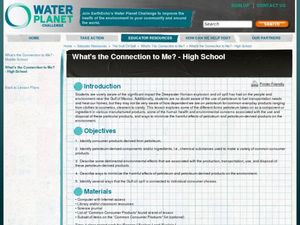Curated OER
Soybeans: The Miracle Seed
Students discover why soybeans are called the "miracle seeds." They make their own soynuts and share other foods made from soybeans. They create a bulletin board of soybean products.
Curated OER
Where's the Beef - Beef Facts or Hype, Is it Bad for You?
Analyze a Happy Meal™ for nutrient content and calories. Blend the contents into "McMush" and use Biuret's solution to test for protein content. There are a few problems with the lesson plan: the resource links are no longer valid, the...
Curated OER
The Tropical Supermarket
Third graders explore the sources of the various foods they eat. They examine how everyone is intricately connected to the ecosystems in which natural resources are produced. Students observe how the lives of people living in those...
Curated OER
Theobroma - Food of the Gods
Students discuss the history of cacao and its use in the production of chocolate. They analyze actual cacao pods and record their observations. Finally they create a five minute contour drawing of the cacao pod and seeds.
Curated OER
To Tell The Truth
Students create a faux ivory napkin ring using art supplies and knowledge gained from in-class discussions and teacher supplied information in this art lesson easily adaptable to a Social Studies or Language Arts classroom.
Curated OER
Prosperity and Challenges
High schoolers watch a slideshow about the technological advances in agriculture. After viewing, they complete an index card about one aspect of the slideshow. In groups, they create a cause and effect timeline in which they identify...
Curated OER
Jackie Steals Home
Students draw on their previous studies of American history and culture as they analyze primary sources from Jackie Robinson and Other Baseball Highlights, 1860s - 1960s in American Memory. A close reading of two documents relating to...
Curated OER
Illinois Biodiversity
Students examine the amount of biodiversity in the state of Illinois. They practice using new vocabulary and listening to stories about animals. After given time to reflect, they write their own haiku. They work together to create a...
Curated OER
Stoichiometry
For this stoichiometry worksheet, students use balanced equations for chemical reactions to determine the percent yield and the mass of product produced. This worksheet has five problems to solve.
Curated OER
Toward a Sustainable Agriculture
Your class considers a case study of a sustainable agro-ecosystem and view a PowerPoint presentation about a sustainable farm. They complete a case study worksheet. Extension activities are included.
Curated OER
Agroforestry Challenge
Students explore agroforestry. In this Peace Corps lesson, students examine the role the trees play in deforestation efforts. Students then participate in an agroforestry game.
Curated OER
Products from the Rainforest
Second graders write a story about the journey a food has from the rainforest to your table. In this food lesson plan, 2nd graders research different foods and products that come from the rainforest and discover how it ended up in their...
Curated OER
Soil: Food Mapping
Young scholars examine the concept of food mapping . In this agriculture instructional activity, students explore food and agriculture systems in the United States in the past and today. Young scholars complete food mapping activities.
Curated OER
Fashion Recycles
Complete fashion design activities as a part of a study on protecting the environment. In this fashion and environment lesson, students discuss global environmental awareness and work in groups to list recyclable products that can be...
Curated OER
Gems in the Market Today
A gem of a lesson! Analyze what makes stones valuable and their aesthetic value. Young gemologists use the Internet to choose what stone they are interested in and then write an advertisement.
Curated OER
Chapter 16, Food Biotechnology
Although the points given on these slides are valid, the visual accessibility is poor. Consequently, many viewers would be distracted or entirely unable to view the presentation. The content is a review of microorganisms and their...
Bridge
Mercury - Mercury is Rising
Hold a discussion in your class about the increase in mercury being found in fish that are caught commercially as food for humans. Given a worksheet, learners then calculate how much fish a person can safely eat each month to remain...
Curated OER
A Safe Food Supply? Is Your Food Safe to Eat?
Viewers of this slide show learn that pesticides used on food crops can be harmful, but that there are certain allowable levels that should not be hazardous. They find out the rigorous process of inspection that meat must go through...
Curated OER
What Should I Know about Biosphere?
If your class is learning about the biosphere, you may find a study guide or reading guide helpful. Focusing on vocabulary, processes, and interactions, the Word document is easy to edit as needed to fit your needs. Another great option...
TerraCycle
What Can Nature Teach Us about Sustainable Design?
Talk about Velcro®, Gecko Tape, WhalePower turbine blades, and other innovations that mimic nature to inspire your STEM or engineering class. This set of worksheets gets them thinking about imitating nature in terms of sustainable...
Curated OER
Food webs and Energy Flows
Students become familiar with food chains. For this food chains lesson, students understand that as consumers eat other consumers energy is passed. Students understand the vocabulary associated with food chains.
Curated OER
What's the Connection to Me?
Students discuss the impact of oil spill to the environment and to their daily lives. In this environmental science instructional activity, students research the pros and cons of petroleum based products. They share their findings in class.
Curated OER
Petroleum Poisons
Students discover how harmful petroleum distillates are that are found in the home. They demonstrate how to collect information about consumer products. They also ask their parents about the safety of the cleaning supplies used in their...
Curated OER
The Portion is the Poison
Middle schoolers calculate the amount of everyday food products or liquids that would need to be consumed in order to become toxic. By using unit analysis, they calculate the amount of certain common food items that would need to be...
Other popular searches
- Family and Consumer Sciences
- Family Consumer Science
- Consumer Science Foods
- Consumer Science Manners
- Health and Consumer Science
- Consumer Science Fibers
- Consumer Science Fibres
- Fm & Consumer Science
- Family & Consumer Sciences
- Consumer Science Fib Res
- Consumer Science Careers
- Food and Consumer Sciences

























